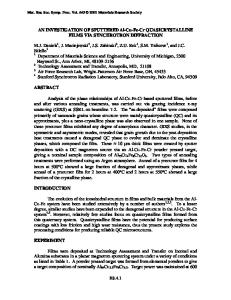An investigation of the Al 86 Mn 14 alloy and its quasicrystalline phases
- PDF / 2,103,925 Bytes
- 10 Pages / 595.44 x 841.68 pts Page_size
- 119 Downloads / 287 Views
I. INTRODUCTION The existence of phases with long-range orientational order and icosahedral point group symmetry in rapidly solidified alloys of aluminum with manganese has been intensively studied during recent years. These new types of quasiperiodic structures are already known as "quasicrystals." 12 Studies of phase formation at slower solidification rates have shown that the icosahedral phase is replaced by the so-called T or decagonal phase.3"5 The icosahedral phase has also been found to solidify in conjunction with other phases, such as Al 6 Mn and the hexagonal phase Al 4 Mn. 4 One of the objectives of this article is the preliminary study of the phases present in an alloy of Al g6 Mn 14 obtained with a relatively slow solidification rate. This investigation was carried out using different techniques such as dark-field and high-resolution transmission electron microscopy, scanning auger spectroscopy, microdiffraction, and image processing techniques. The understanding of the structure of quasiperiodic phases has been the object of a large number of recent investigations. Shechtman et al.,1 in the initial work on this topic, have proposed that the fivefold symmetry can be obtained with a random arrangement of nonoverlapping icosahedra attached by the edges. Field and Fraser,6 on the other hand, have suggested a model based on the multiple twinning of a distorted cubic crystal, which has been ruled out by many high-resolution and microdiffraction studies.7"9 Structural models based on threedimensional Penrose lattices have also been suggested 10 ' 12 ; however, they were unable to fully predict some of the experimental results obtained. The main problem that remains is the exact matching of experimental highresolution atomic images with theoretical models.13 Bursill and Lin14 have presented a model based on truncated icosahedral clusters that were identified as the elemental building blocks of the icosahedral phase. They J. Mater. Res. 2 (2), Mar/Apr 1987
http://journals.cambridge.org
were able to match some of the image contrast features in the fivefold high-resolution images. In the present article we present experimental evidence on the different phases (including the quasicrystalline "7"') observed in Al 86 Mn 14 alloys. Another objective of this article is to describe a lattice model for the quasicrystal. The model is based on a decagonal generator, which can reproduce most of the image contrast features in a highresolution picture obtained under fivefold diffraction conditions. II. EXPERIMENTAL PROCEDURE Alloys have been prepared by a mixture of 86 at. % Al and 14 at. % Mn of high purity and using a standard fundent. The liquid alloy was poured in a steel mold held at liquid nitrogen temperature. The samples for the scanning Auger microscope were polished with HNO 3 and further cleaned in alcohol. The x-ray measurements were made with a step-scanning diffractometer with angular steps of 0.05° and MoK-a radiation. In order to avoid background signals the specimen in this case was supported in collodion
Data Loading...











